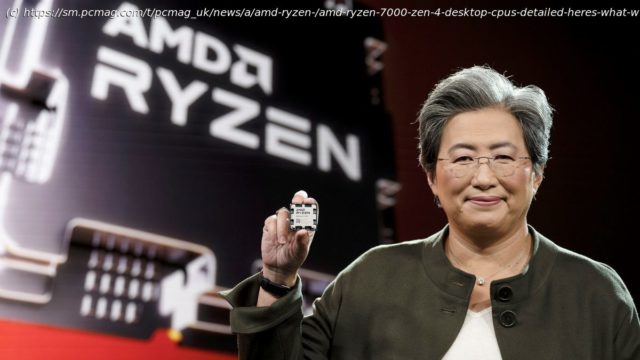The first Ryzen 7000 chips go on sale Sept. 27, and AMD just made official the initial specs and lots of new platform details. Here’s the latest on the new architecture, socket, and silicon, coming soon to power-user and gaming PCs near you.
At a press and analyst event in Austin, Texas, AMD unsealed its plans for its much-anticipated Ryzen 7000 desktop CPU line, code-named “Raphael.” First tipped at CES 2022, the Ryzen 7000 will be the first set of consumer chips to employ the new “Zen 4” microarchitecture with leading-edge process technology. The first chips in the new line will target power users and gamers.
The Zen 4 essentials were shared by AMD’s Chair and CEO Dr. Lisa Su, and CTO Mark Papermaster. Built on 5-nanometer process technology from TSMC for its CCDs (the I/O portion, home to the PCIe 5.0 and memory controllers, is on 6nm), the Ryzen 7000 is the first large-scale architectural advance from AMD on its desktop processors since 2020. November of that year saw the launch of “Zen 3” to consumers, in Ryzen 5000 desktop (“Vermeer”) chips like the Ryzen 9 5900X, and Zen 3 was expanded to the company’s workstation-grade Threadripper Pro chips in 2022. Zen 3 came to laptops after the initial Zen 3 launch, in the 5000-series-mobile “Cezanne” line (the first of which debuted in January 2021) and a later refresh in the form of Ryzen 6000 H- and U-series mobile CPUs (“Rembrandt”) in early 2022. (See our initial tests of laptop samples bearing Cezanne and Rembrandt mobile chips.)
Now at the end of 2022 we will get our first taste of something new from AMD after two long years of waiting. A Ryzen 6000 desktop-CPU family never materialized, though some integrated-graphics-equipped (IGP) Ryzen 5000 CPUs and enhanced Ryzen 4000 chips (formerly OEM-only) fleshed out the desktop line between 2020 and present. Thus the pent-up demand for more detail on AMD’s latest big chip update, coming on the heels of Intel’s own largely successful 12th Generation « Alder Lake » launch (and its upcoming 13th Gen Core).
2022’s Ryzen 7000 family is not just a long-awaited refresh to the Ryzen line, but AMD is bringing with it more new base-level technologies than any launch since the original, revolutionary Ryzen 1000 series in 2017. AMD broke it all down at its launch event. Strap in…it’s a lot!First, the CPUs: Ryzen 7000 Desktop Specs and Models
Let’s first take a look at the first Ryzen 7000 chips AMD made official. Plenty of leaks have hinted at the identity of these chips in the run-up to today’s event, but here is the initial launch lineup. It comprises four distinct chip SKUs in the Ryzen 9 (two of those), Ryzen 7, and Ryzen 5 lines…
Now, these are clear enthusiast-grade processors with obvious parallels in the Ryzen 5000 series (the Ryzen 9 5950X and 5900X, Ryzen 7 5700X, and Ryzen 5 5600X). You will note the lack of chips ending in “G,” which has traditionally signified on-chip graphics for a select few Ryzens. Now, on-chip Radeon Graphics (based on “RDNA 2” architecture) is the norm, not the exception. (More about that in a bit.)
One thing that is not different is the classification of cores: They are all of one undifferentiated type. With its 12th Generation (“Alder Lake”) CPUs, Intel in most of its mainstream and higher-end desktop and laptop chips established two classes of core making up the die: Performance cores, and Efficient cores (P-cores and E-cores, respectively). The two types are designed for different classes of task; relegating easy or non-time-sensitive tasks to E-cores can save energy. (E-cores also do not support multithreading.) The P-cores and E-cores can also be deployed together for peak multithreaded muscle in applications designed to leverage them both. Here, the core types are one.
AMD uncorked some general, family-wide Zen 4 performance claims, which we’ll outline here; following that are some claims on the highest-end and lowest-end Ryzen 9 and Ryzen 5 CPUs. Overall, against the Ryzen 5000, AMD is claiming an approximate 13% IPC uplift vs. those Zen 3 processors on average, and a 29% uplift on single-threaded performance vs. same. (The IPC uplift figure is a few percentage points higher now than the company’s original claims from Computex 2022.) The top-end boost clock, on the Ryzen 9 7950X, also tops that of the 5000 series by a whopping 800MHz.
The chip maker also shared the following Geekbench 5.4 single-thread performance projection for the four Zen 4 chips vs the Intel Core i9-12900K, Team Blue’s Alder Lake flagship chip…
The single-threaded performance boost is the most interesting aspect of these claims, given that that has traditionally been an AMD sore point vs. equivalent Intel chips. The known effect of good single-threaded performance on games, all else being equal, is also an intriguing factor here. AMD Ryzen 9 7950X: The New Flagship
The 7950X is the 16-core flagship. Here, AMD is claiming some pretty healthy upticks in selected games and content-creation applications vs. its own last-generation equivalent, the Ryzen 9 5950X…
Given that there is no change in core/thread count here, the content creator upticks raise some intrigued eyebrows.






